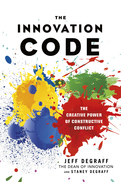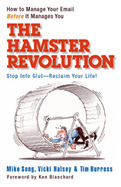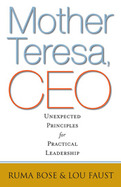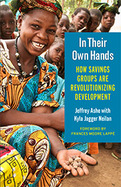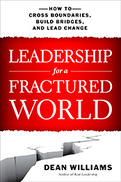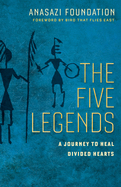2017
The Creative Power of Constructive Conflict
Harmony is sublime in music but deadly to innovation. The only way to create new, hybrid solutions is to clash. Innovation happens when we bring people with contrasting perspectives and complementary areas of expertise together in one room. We innovate best with people who challenge us, not people who agree with us.
It sounds like a recipe for chaos and confusion. But in The Innovation Code, Jeff DeGraff, dubbed the “Dean of Innovation,” and Staney DeGraff introduce a simple framework to explain the ways different kinds of thinkers and leaders can create constructive conflict in any organization. This positive tension produces ingenious solutions that go far beyond “the best of both worlds.”
Drawing on their work with nearly half of the Fortune 500 companies, the DeGraffs help you harness the creative energy that arises from opposing viewpoints. They identify four contrasting styles of innovator—the Artist, the Engineer, the Athlete, and the Sage—and include exercises and assessments for building, managing, and embracing the dynamic discord of a team that contains all four. You can also figure out where you fit on the continuum of innovator archetypes.
Using vivid examples, The Innovation Code offers four steps to normalize conflict and channel it to develop something completely new. By following these simple steps, you will get breakthrough innovations that are both good for you and your customers. This is a rigorous but highly accessible guide for achieving breakthrough solutions by utilizing the full—and seemingly contradictory—spectrum of innovative thinking.
Just in time, Harold meets a coach—a leading expert on email efficiency and etiquette with a simple system that helps Harold eliminate needless emails, write better messages, and file and find information in a flash. He gets immediate results—and reclaims his life.
The Hamster Revolution is chock-full of practical advice that really works. Included is a landmark case study that shows how 2,000 Capital One associates cut their email time by 23 percent while improving overall email quality by 52 percent.
Professionals waste up to a month per year on email—costing their companies billions in missed opportunities. The good news? Hope and help are here. The Hamster Revolution is the definitive book for our times.
2011
Offers ten suprising leadership lessons and shows how they can improve snd enrich any leader or organization.
-
The first book to portray Mother Teresa as the realistic, pragmatic leader of one of the world's most recognized and successful global organizations
-
Offers eight surprising leadership lessons and shows how they can improve and enrich any leader or organization
-
Draws on coauthor Ruma Bose's firsthand experiences working with Mother Teresa
When most people think of Mother Teresa, they think of a saint--a spiritual hero of extraordinary humanitarian accomplishments, a Nobel Peace Prize winner. But Mother Teresa was also the leader of one of the world's largest and most successful organizations: the Missionaries of Charity. Since founding it in 1948 she has raised billions of dollars, and with over a million volunteers in more than 100 countries, it remains one of the most recognized brands in the world. How did one nun who never received any formal education in business build such an impressive global organization?
Frank, realistic, and firmly grounded in practicality, Mother Teresa's leadership style helped to inspire and organize people across the world. This book shares eight essential leadership principles drawn from Mother Teresa's example and applies them to today's business world. Authors Ruma Bose, an entrepreneur who volunteered with Mother Teresa, and Lou Faust, a leading business expert, are the first to examine her in this light--as a leader whose management style and dedication to a singular vision led to one of the world's most unlikely success stories.
Mother Teresa may have been a saint, but her spectacular success was not a product of divine providence. Her genius was the simplicity of her vision and her dedication to its implementation. It was in the way she treated her people, refusing to distance herself from the everyday work of a typical sister of the Missionaries of Charity. It was in how she handled tough choices--like accepting donations from brutal Haitian dictator Francois "Papa Doc" Duvalier. These were the principles that made her the great leader of a global organization, and they can be applied by anyone in any organization--no sainthood required.
2014
- A better way to fight poverty: Ashe and Neilan show that savings groups are simple, extremely low cost, self-managing and spread virally-there are savings groups in 100,000 villages in 65 countries
- Sponsored by Oxfam America: This book was developed with Oxfam America, part of an international coalition of Oxfams operating in 90 countries-in 2005 Ashe and Oxfam, with their partner Freedom from Hunger, pioneered a program to expand savings groups worldwide.
Two and a half billion people worldwide, too poor and too rural to be served by traditional financial institutions desperately need a better way to save and borrow. Jeffrey Ashe and Kyla Jagger Neilan say the answer is savings groups.
In savings groups, members put what they can in a communal pot and make loans to individual members for needs like buying food to survive the "lean season" before the harvest, building a business, investing in livestock, or paying school fees. Once a year, the entire pot plus interest on loans is divided among the members. Unlike other poverty alleviation options, savings groups are run entirely by their members, and, they spread by word of mouth from village to village, allowing them to reach remote areas with remarkable success. By catalyzing the problem-solving capacity of the poor they avoid subsidies, debt, dependency, and high costs while reducing hunger and building assets and solidarity.
Ashe and Neilan show that applying savings group principles could revolutionize development in areas as diverse as health, agriculture, education and grassroots political empowerment. "Being organized gives us courage," as one woman said. It is their courage translated into action that explains the success of "in their own hands" development.
Drawing on what he's learned from years of working in countries and organizations around the world, Williams shows leaders how to approach the delicate and creative work of boundary spanning, whether those boundaries are cultural, organizational, political, geographic, religious, or structural. Sometimes leaders themselves have to be the ones who cross the boundaries between groups. Other times, a leader's job is to build relational bridges between divided groups or even to completely break down the boundaries that block collaborative problem solving. By thinking about power and authority in a different way, leaders will become genuine change agents, able to heal wounds, resolve conflicts, and bring a fractured world together.
2019
The Five Legends tells the story of two estranged brothers, leaders of their people, who find themselves on an unexpected journey. Struggling against each other, they stumble and fall into a great and terrible canyon. Trapped, the two brothers are rescued by an old man—“the last of a people”—who offers to guide them out of the canyon if they agree to learn the five legends of peace. The brothers agree and begin a journey that may not only save themselves, but also their people.
The brothers learn that to heal any conflict we must first look within ourselves. As this fable beautifully puts it, “War does not begin or end with armies and leaders. In truth, war begins and ends within each of us—within our hearts. When we choose to war with others, we turn our hearts away from them and blind ourselves to their light. …To have a heart at war is to invite war into your life.” The path to peace begins when we stop thinking about “me” and start thinking about “WE.”
This poetic and moving allegory is written for all ages. Its message is both timeless and desperately needed for our own time


